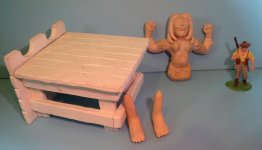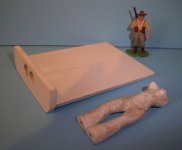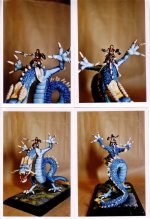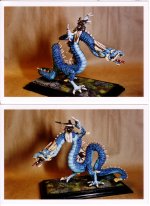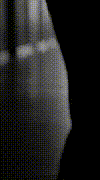-
If you would like to get your account Verified, read this thread -
The TMF is sponsored by Clips4sale - By supporting them, you're supporting us. -
>>> If you cannot get into your account email me at [email protected] <<<
Don't forget to include your username
You are using an out of date browser. It may not display this or other websites correctly.
You should upgrade or use an alternative browser.
You should upgrade or use an alternative browser.
The Low Roads, chapter 1 (comic strip, FF/F, full body/foot).
Low_Roads
4th Level Black Feather
- Joined
- Nov 16, 2004
- Messages
- 8,972
- Points
- 48
The laconic approach has paid off, K! Here are the photos I promised!
#1. Incomplete figure and stocks. The victim (Mercy again) has been sculpted from the oven-hardening clay, Sculpey-III. The stocks are made from Trovecil, a sheet plastic used in sign-making. The 1/32 soldier is not on guard: he has been included for scale.
#2. Closer shot of Mercy's torso and feet. All I have to do is hook them up!
#3. The second figure, torso and legs, shaped from sheet plastic with a hot-knife. The examination table is again Trovecil.
One day I'll finish these diaramas. No rush. They aren't going anywhere!
#1. Incomplete figure and stocks. The victim (Mercy again) has been sculpted from the oven-hardening clay, Sculpey-III. The stocks are made from Trovecil, a sheet plastic used in sign-making. The 1/32 soldier is not on guard: he has been included for scale.
#2. Closer shot of Mercy's torso and feet. All I have to do is hook them up!
#3. The second figure, torso and legs, shaped from sheet plastic with a hot-knife. The examination table is again Trovecil.
One day I'll finish these diaramas. No rush. They aren't going anywhere!
Attachments
Kalamos
Level of Lemon Feather
- Joined
- Jul 13, 2003
- Messages
- 12,939
- Points
- 63
Great!Littlebighead said:One day I'll finish these diaramas. No rush. They aren't going anywhere!
We are, though.
😉
scavenger
1st Level Red Feather
- Joined
- Jan 18, 2005
- Messages
- 1,138
- Points
- 0
Oh my! You're a sculptor too! And your sculpture looks great!
Actually, sculpting is also one of my hobbies. Well, mostly I do 28 mm scale (thats the standard scale for wargames), and I never did any tickling related stuff before. But perhaps I should give it a try though.
On side not: instead of Sculpey I use Milliput or Kneadatite; two-component, self hardening resins. very handy stuff 🙂
Actually, sculpting is also one of my hobbies. Well, mostly I do 28 mm scale (thats the standard scale for wargames), and I never did any tickling related stuff before. But perhaps I should give it a try though.
On side not: instead of Sculpey I use Milliput or Kneadatite; two-component, self hardening resins. very handy stuff 🙂
Low_Roads
4th Level Black Feather
- Joined
- Nov 16, 2004
- Messages
- 8,972
- Points
- 48
Thank you scavenger! And please, do try a tickling sculptre! I'd love to see your work! Models and diaramas are an under-represented venue on this site, to the point that you barely see them. It would be terrific to have some creative, high-profile examples on display!
Thanks for the tip about the resins. I think Michaels (the local chain crafts store) carries Milliput. I've seen it somewhere, anyway. I'll defintely have to try it out!
Thanks for the tip about the resins. I think Michaels (the local chain crafts store) carries Milliput. I've seen it somewhere, anyway. I'll defintely have to try it out!
Last edited:
nessonite1
3rd Level White Feather
- Joined
- Sep 20, 2003
- Messages
- 9,517
- Points
- 0
Amazing how youve translated your character into 3D! It looks just like her! I tried my hand at sculpey and it just wasn't there lol
Low_Roads
4th Level Black Feather
- Joined
- Nov 16, 2004
- Messages
- 8,972
- Points
- 48
Thanks for saying so, ness! And I'm sorry about your own model. I really was looking forward to seeing it. I know you had trouble in the oven, though, breaking off an arm that had to be glued back. No need to feel special about that... the same thing happened to me. Mercy's right arm came loose at the shoulder and I had to pin it in place. That Sculpey can be a trecherous medium! I hope Milliput is easier to work with.
nessonite1
3rd Level White Feather
- Joined
- Sep 20, 2003
- Messages
- 9,517
- Points
- 0
I'll try again ^^ I bought a big box of sculpey
Low_Roads
4th Level Black Feather
- Joined
- Nov 16, 2004
- Messages
- 8,972
- Points
- 48
That's the spirit, ness! I look forward to seeing a cute anime sculpture!
Thanks for low-down and the warning, K. It might be worth a little skin rash for a pleasing result. Rubber gloves could always be worn, I suppose. But I really prefer to feel the medium as I work it.
Thanks for low-down and the warning, K. It might be worth a little skin rash for a pleasing result. Rubber gloves could always be worn, I suppose. But I really prefer to feel the medium as I work it.
scavenger
1st Level Red Feather
- Joined
- Jan 18, 2005
- Messages
- 1,138
- Points
- 0
Well, actually I never had any skin-rash problems with milliput. I believe this applies mostly to people with a very senstive skin, or allergic reaction on this stuff. I personally never use gloves, they hinder a lot when sculpting intricate details.
As for the properties of Milliput, it is amazing stuff (be sure to get the "superfine" white version). Appearantly it was originally designed as a heavy duty filler, for filling holes in ship hulls, reservoirs etc. It hardens by the reaction of it's two components, not by being exposed to heat or to the air. This means it even hardens underwater!
Be careful though: don't mix up to much at a time: it begins hardening after an hour/two hours. The reaction (which causes the hardening) can be slowed down if you put the milliput in the fridge (or in a freezer). You can speed up the proces by putting the milliput NEAR a heat source (an oven will be too hot!). By using the latter method it's possible to get the milliput rock hard in half an hour.
After hardening, the milliput can be drilled, sanded, sawed... etc.
And like Kalamos said, it can be thinned down with water, just like natural clay.
I'll look for some pictures of my past projects to show you.
As for the properties of Milliput, it is amazing stuff (be sure to get the "superfine" white version). Appearantly it was originally designed as a heavy duty filler, for filling holes in ship hulls, reservoirs etc. It hardens by the reaction of it's two components, not by being exposed to heat or to the air. This means it even hardens underwater!
Be careful though: don't mix up to much at a time: it begins hardening after an hour/two hours. The reaction (which causes the hardening) can be slowed down if you put the milliput in the fridge (or in a freezer). You can speed up the proces by putting the milliput NEAR a heat source (an oven will be too hot!). By using the latter method it's possible to get the milliput rock hard in half an hour.
After hardening, the milliput can be drilled, sanded, sawed... etc.
And like Kalamos said, it can be thinned down with water, just like natural clay.
I'll look for some pictures of my past projects to show you.
scavenger
1st Level Red Feather
- Joined
- Jan 18, 2005
- Messages
- 1,138
- Points
- 0
here's some pictures:
Two of my projects of the last year. Both dragons are at 28 mm scale (which would be around 1:56 ) as the riders are both 28 mm.
For the green dragon I made a silicone mould of the original sculpted parts, and casted it in polyurethane resin.
Two of my projects of the last year. Both dragons are at 28 mm scale (which would be around 1:56 ) as the riders are both 28 mm.
For the green dragon I made a silicone mould of the original sculpted parts, and casted it in polyurethane resin.
Attachments
Low_Roads
4th Level Black Feather
- Joined
- Nov 16, 2004
- Messages
- 8,972
- Points
- 48
Please do! I'm most interested in seeing them!scavenger01 said:I'll look for some pictures of my past projects to show you.
Thanks for the detailed information! I'm glad to know which variety of Milliput to look for. That'll really save time and experimentation. No fears about making up too much at one time... I tend to work accumlatively, in smallish quanitites, anway. That's one of the reasons the Mercy figure has taken so long to finish: I'd add one detail, then have her back in the oven to secure it. She's probably made 40 trips into the oven just to get this far!
Low_Roads
4th Level Black Feather
- Joined
- Nov 16, 2004
- Messages
- 8,972
- Points
- 48
Those dragons are absolutely stunning, scavenger! Brilliantly conceived, sculpted and painted! You really should post these pictures in the non-tickling images forum too! Not nearly enough people are going to see them here! Just unbelievable work!
Kalamos
Level of Lemon Feather
- Joined
- Jul 13, 2003
- Messages
- 12,939
- Points
- 63
Have you ever tried acrylic thinners or retardants?scavenger01 said:the smooth finish is mostly due to the way I painted the belly: successive glazings of thinned down paint.
Read they make for very subtle finish.
nessonite1
3rd Level White Feather
- Joined
- Sep 20, 2003
- Messages
- 9,517
- Points
- 0
OMG those are amazing!
scavenger
1st Level Red Feather
- Joined
- Jan 18, 2005
- Messages
- 1,138
- Points
- 0
Thank you, Ness! 🙂
Kalamos: Yes I've heard of them. I'm not going to use retardants though, the fast drying speed of acrylics is just what I like about them (as opposed to oilpaints, which even with an accellerator take a week to dry). Acrylic medium might be useful, though, as it's needed to make easy non-patchy glazings (water tends to be drying in pools, resulting in an uneven spread of the pigment). I think I'll experiment with those sometime when I get the opportunity.
Kalamos: Yes I've heard of them. I'm not going to use retardants though, the fast drying speed of acrylics is just what I like about them (as opposed to oilpaints, which even with an accellerator take a week to dry). Acrylic medium might be useful, though, as it's needed to make easy non-patchy glazings (water tends to be drying in pools, resulting in an uneven spread of the pigment). I think I'll experiment with those sometime when I get the opportunity.
Darth Vegeta
4th Level Yellow Feather
- Joined
- Mar 8, 2003
- Messages
- 3,910
- Points
- 38
Magnificent comic. VERY well done.
What's New
11/13/25
Visit the TMF Links forum for updates on tickling sites all around the web.
Visit the TMF Links forum for updates on tickling sites all around the web.
Streaming Videos
Congratulations to *** brad1701 *** The winner of our weekly Trivia,
held every Sunday night at 11PM EST in our Chat Room


